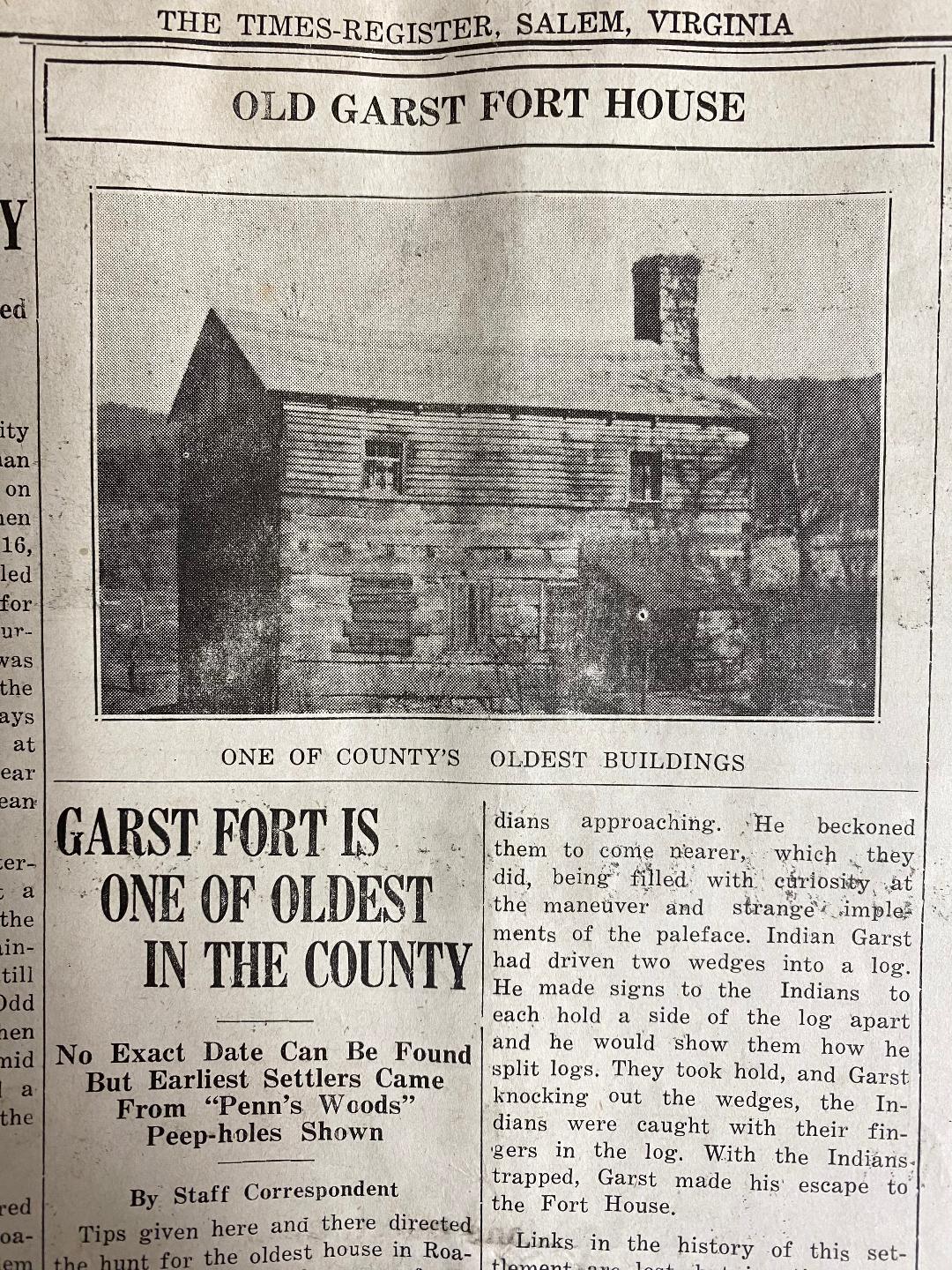
No Exact Date Can Be Found But earliest Settlers Came From “Penn’s Woods” Peep-holes Shown
From the 1938 centennial edition of The Times-Register
By Staff Correspondent
Tips given here and there directed the hunt for the oldest house in Roanoke County. We believe we found it when we sighted the old Garst Fort House in a walnut grove near Green Ridge.
This ridge, green all the year round, running along the base of Brush Mountain is watered by numerous springs, and it is easily understood why settlers should choose this spot for making camp. Here, where water was plentiful, where the forest was dense and game abounded, where the approach of the enemy could be sighted from every direction, a little band of white settlers built a settlement house so planned that in case of attack they could have access for weeks at a time, to a well supplied larder and to water, without leaving the place.
Frederick Garst Settled Here
In just what year that happened, could not be learned, but tracing back the threads of information given as a memory record from several sources, this became known as the Garst Fort House, from having been occupied by Frederick Garst and this party that drifted in here from Penn’s Woods (Now Pennsylvania), and originally were immigrants from Germany. It is not known whether the Garst party were the builders of the first occupants.
Built of logs hewn from the virgin forest, the house still stands a monument to those first builders. It is a three-story building at the front, where the ground floor rests on the side of the hill. At the back, it is four story, wich the stone basement forming the foundation that has withstood the weathering of apparently, an approach to two centuries. Through the center of the natural rock floor of the basement, runs a wide, cold, clear stream of water from the spring gushing from the rock foundation. In either side of the basement, built against the wall, remain portions of the storage bins for food supplies. A stairway leads to the upper stories. The first and second loors evidently, were the main residential portions of the house, large enough to accommodate several families. The story goes that the Fort House was originally enclosed by a stockade but markings of this have been effaced.
The third floor, recently re-roofed by the new owner, has lowered the building; but when visited several years ago, the writer found the third floor intact as it was originally planned. It was a long garret room under a sloping roof, and which apparently served as a general work room. There were remnants of a hand loom, quilting frame, hand-made rocker crib and other furniture, and parts of a cobbler’s outfit. A few remaining specimens of children’s handmade shoes of rawhide hung from one of the rafters.
Has a Centry Tower
The wide rock chimney which forms the flue to the great open fireplace in the first floor, is narrowed at the third floor, where it set about two feet beyond the walls. Back of this chimney, but invisible from the outside, is a square peephole from which observations could be made. This was the centry tower of the Fort House.
A story is told by Mr. Joel Garst, about one of his forebears, whose name name has come down through the generations as the cunning “Indian” Garst. While splitting logs in the woods one day, Garst saw some Indians approaching. He beckoned them to come nearer, which they did, being filled with curiosity at the maneuver and strange implements of the paleface. Indian Garst had driven two wedges into a log. He made signs to the Indians to each hold a side of the log apart and he would show them how he split logs. they took hold, and Garst knocking out the wedges, the Indians were caught with their fingers in the log. With the Indians trapped, Garst made his escape to the Fort House.
Links in the history of this settlement are lost, but in time, the property came into the possession of one Christley Swartz, from whom it decended to Jacob Showalter (recent former owner) through his first wife who was Swartz’ daughter.
Some weteran walnuts still form a shade grove about the Old Garst Fort House. If these trees could talk, it would be easy to write the history of those early which settlers who braced dangers of pioneering that this beautiful valley might one day become the home of their descendants.
____________________________
The old manor house, or plantation home, is now about a thing of the past in the south. It is said that before the civil war a traveler on a Mississippi steamboat was seldom out of sight of one of these fine homes.
– Prepared by Lingjie Gu




